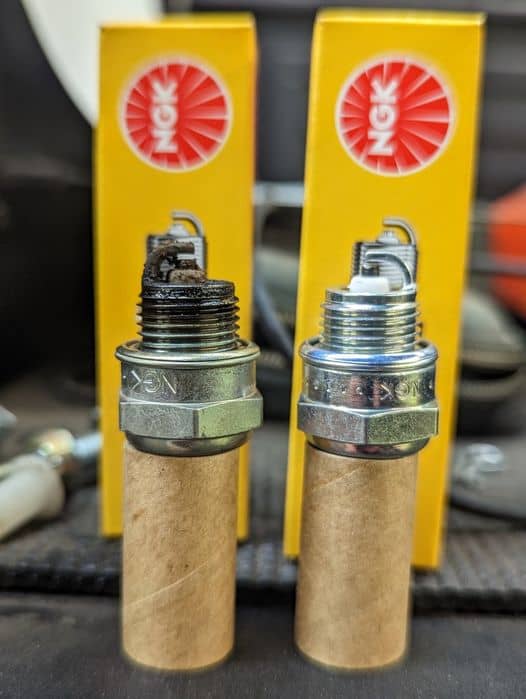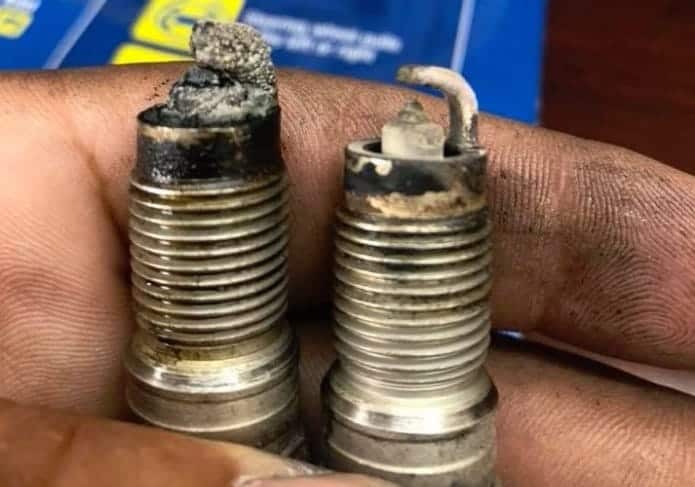Dear,
Why does my lawn mower spark plug keep fouling? This question may leave you frustrated, but you are not alone. We are here to help you!
We understand the annoyance of the fouled spark plug. Hence, we will help you to explore the possible causes behind this problem.
Join us to know the causes and learn how to fix them!
Contents
Why Does My Lawn Mower Spark Plug Keep Fouling?
The spark plug of your lawn mower may foul because of the clogged air intake or fuel injector. Other causes of the problem can be the faulty PCV and piston rings.
Clogged air intake
What causes fouled spark plugs in lawn mowers? Carbon buildup should be the first reason to check. It often happens because of the combustion system’s improper oxygen and fuel mixture.
You may add too much fuel, making the mixture too rich. Then, your machine will produce more smoke, increasing the chance of carbon buildup in the electrodes. The spark plug may turn black, too.
When there is a blockage in the engine’s air intake, the air can’t flow properly. To solve this problem, please try these steps:
- Check the air filter and connections for any obstructions, such as debris, dust, and grass clippings.
- Use a brush to clear debris from the air filter.
- If the air filter has got damaged, replace it.
- Ensure the connections between the throttle, choke plates, and carburetor are free from blockages. If not, use a suitable cleaner to remove the obstructions.
- Vibrations from the engine may cause the screws holding the carburetor connections to become loose. In this case, tighten them with a screwdriver.
Fuel injector blockage
A clogged fuel injector creates an imbalanced fuel mixture. So, it won’t burn hot enough, accumulating carbon in the spark plug and other engine components.
Fixing a clogged fuel injector in a lawn mower may require more specialized attention. Here is what you need to do:
- Turn off the fuel valve.
- Remove the fuel line and check it for any clogs. If you see any obstructions, remove them.
- Clamp the fuel line to the pump to stop the fuel flow.
- Remove the pump and check for any cracks or damage.
- If you notice blockages in the pump, clean them.
Depending on the design of the fuel injector, you may need to open the engine with specialized tools and solutions. There are some unseen clogs that only experts can remove.

Problems with the PCV
The PCV, or crankcase breather, allows exhaust gas from the fuel combustion process to exit the chamber. If it becomes loose or broken, the oil may leak into the combustion chamber, resulting in oil fouling of the spark plug.
To address this problem, please try out these steps:
- Find the PCV, which is often above the valves. You can remove the muffler to access it.
- Check the breather for any signs of oil or dirt, and clean it.
- Remove the breather using a screwdriver, then check for damage and obstructions. If the diameter of the hole is wider than .045 inches, you need to replace the breather.
Faulty piston rings
When the piston rings in a lawn mower’s engine get damaged, it will lead to oil fouling of the spark plug. This issue occurs when oil leaks into the combustion chamber, resulting in a translucent coating on its surface.
The instructions for fixing this problem are as follows:
- Disconnect the wiring and remove the spark plug.
- Crank the engine to clear excess oil and liquid from the cylinder.
- Reinstall the spark plug.
- Loose the lug nut to observe the gas flow through the carburetor. Then, remove the oil there.
- Check the oil level of the lawn mower. If it’s too low, add more to bring it back to the recommended level.
- Start the engine again until the smoke becomes clear. This step helps burn off the remaining oil residue in the exhaust system and combustion chamber.
- Finally, reinsert the air filter to ensure proper filtration.

When To Check And Replace Spark Plugs?
To maintain standard lawn mowers and small engines, you should check or, if necessary, replace spark plugs at least once a season.
However, if you don’t often use your lawn mower, the rule above may not work. Instead, consider inspecting the spark plug in two cases:
- Every 25 hours of running
- Faulty or damaged parts
If you encounter difficulties starting your lawn mower, it’s a sign that spark plugs might need attention. Faulty or worn-out spark plugs can hinder ignition and lead to starting issues.

Tips To Maintain Lawn Mower Spark Plug
Proper spark plug maintenance is essential for your lawn mower’s performance. Here are some practical tips to help you with this task:
- Check the spark plug for any signs of damage, wear, and fouling.
- Use the correct spark plug for your lawn mower. Please note that spark plugs are not universal. If you use the wrong model, you will notice damage soon.
- Clean the spark plug regularly to avoid dirt accumulation.
- Use a gap gauge to measure and adjust the spark plug electrode gap.
- Tighten the spark plug properly when you reinstall it.
- Use high-quality fuel to prevent fouling in the spark plug. Check the fuel level frequently, too.
This video will show you a general idea of checking and cleaning the spark plug:
Conclusion
Understanding why your lawn mower’s spark plug keeps fouling helps you maintain it properly. If you get stuck in this situation, check the air intake, fuel injector, PCV, and piston rings. Then, follow the tips highlighted above to solve it.
Hopefully, you can say goodbye to the fouled spark plug. If the problem persists, do not hesitate to ask us for help.
Thank you for reading!


